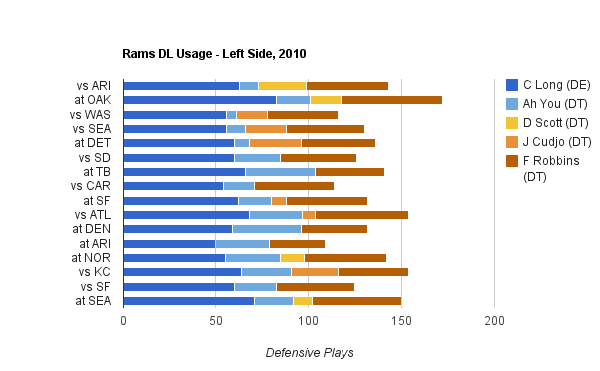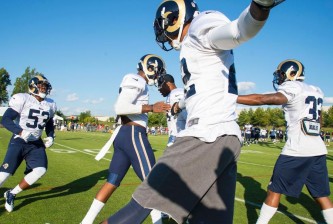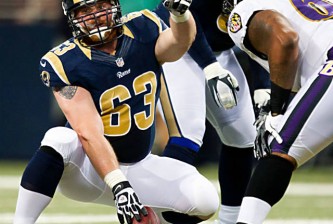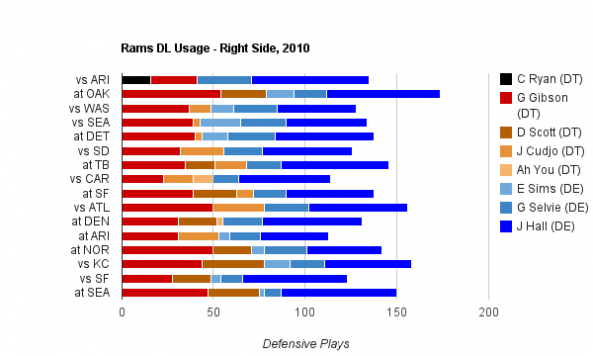 James Hall and the Rams’ rebuilt defensive line increased their sack total from 25 to 43 in one season. Mission accomplished? Or just beginning?
James Hall and the Rams’ rebuilt defensive line increased their sack total from 25 to 43 in one season. Mission accomplished? Or just beginning?Despite a seemingly annual procession of high draft picks, the Rams’ defensive line always played as less than the sum of its parts, until 2010. The transformation, led by coach Spagnuolo, started by letting go of one high draft pick (underperforming DT Adam Carriker) and not working very hard to entice its best pass rusher (DE Leonard Little) out of retirement. The only additions to the line were a 33-year-old defensive tackle (Fred Robbins) and a pair of third-day draft picks (Eugene Sims and George Selvie). However, these minimal changes had a hugely positive effect on the overall play of the line.
The Rams’ defensive line improved radically from 2009 to 2010 by a number of measureable metrics, however, it failed to improve by one key stat:
-
Sacks: 29th in the NFL (25 total) in 2009 …. 7th in the NFL (43 total) in 2010.
-
Adjusted Sack Rate (sacks per pass attempt): 27th in the NFL (5.4%) in 2009 …. 8th in the NFL (7.1%) in 2010
-
Opponent’s passer rating: 31st in the NFL (96.9) in 2009 …. 9th in the NFL (80.4) in 2010
-
Opponent’s yards per rush: 20th in the NFL (4.4) in 2009 …. 22nd in the NFL (4.5) in 2010
While moving James Hall (right side) and Chris Long (left side) to their natural positions helped the team take a quantum leap against the pass, the weakness of their interior line couldn’t generate any improvement versus the run. Moreover, while most teams utilize rotations with their defensive front four, the constant cycling of players in and out of the lineup at some spots suggests more desperation than plan.
To illustrate this, here is what the Rams’ left side of the defense looked like, on a per-snap basis. (Stats via ProFootballFocus.com)

The left side was relatively stable, with Long and Robbins taking a big percentage of the available snaps at their positions, and a short list of useful cogs rotating in as needed. Compare this stability to the right side of the line:
Not only was Hall (826 total snaps) on the field less than Long (987 snaps), his opening-day linemate, Clifton Ryan, played only 16 snaps before being lost for the year with a severe concussion. This led to a desperate carousel of undersized players rotating in and out of the right DT spot. Gary Gibson tried to hold down the fort, Jermelle Cudjo and CJ Ah You provided a spark here and there, and often Spags would rotate an extra DE in there (Selvie or Sims) in an attempt to generate an unexpected rush angle. But none of these players is an ideal long-term fit for the position.
However, there’s no question that the Rams could benefit not only from stability at this spot, but from legitimate double-team-breaking talent. The right DT in the Rams system usually lines up in the gap between Center and Guard, often shaded toward the Center. You need strength, bulk, and quickness to stand up to the pounding that this position takes all season long.
Moreover, the Rams often activated eight or even nine defensive linemen on gameday, to fill this void that Ryan’s departure left. With a stronger presence, you can whittle that number down to seven, and keep an extra DB, WR, or give a rotational guard like John Greco more work. (If you’re wondering why Greco and Gilyard saw so little time down the stretch, this need on the D line was a big reason why.)
Bottom line, expect DT to be a big focus of the Rams on draft day. If the Rams don’t select a WR in the first round, it would not be a surprise to hear a player like Marvin Austin or Christian Ballard’s name called; if they do, perhaps a player with coachable potential like Allen Bailey gets snagged in the next few rounds.























